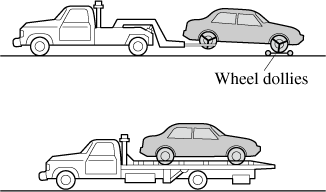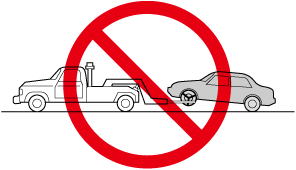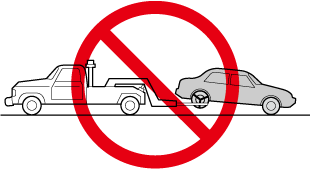Towing Description
We recommend that towing be done only by an expert repairer, we recommend an Authorised Mazda Repairer or a commercial tow-truck service.
Proper lifting and towing are necessary to prevent damage to the vehicle. Particularly when towing a 4WD vehicle, where all the wheels are connected to the drive train, proper transporting of the vehicle is absolutely essential to avoid damaging the drive system. Government and local laws must be followed.

A towed 2WD vehicle should have its drive wheels (front wheels) off the ground. If excessive damage or other conditions prevent this, use wheel dollies.
When towing a 2WD vehicle with the rear wheels on the ground, release the parking brake.
A towed 4WD vehicle must have all its wheels off the ground.
Always tow a 4WD vehicle with all four wheels off the ground:
Towing a 4WD vehicle with either the front or rear wheels on the ground is dangerous as the drive train could be damaged, or the vehicle could trail away from the tow truck and cause an accident. If the drive train has been damaged, transport the vehicle on a flat bed truck.



-
Do not tow the vehicle pointed backward with driving wheels on the ground. This may cause internal damage to the transaxle.

-
Do not tow with sling-type equipment. This could damage your vehicle. Use wheel-lift or flatbed equipment.



If towing service is not available in an emergency, the vehicle may be towed with all four wheels on the ground using the towing hook at the front of the vehicle.
Only tow the vehicle on paved surfaces for short distances at low speeds.
Follow these instructions when towing the vehicle with all wheels on the ground.
-
Shift to neutral (Manual transaxle), or the N position (Automatic transaxle).
-
Switch the ignition to ACC.
-
Release the parking brake.
Remember that power assist for the brakes and steering will not be available when the engine is not running.




 Read this first
Read this first



















